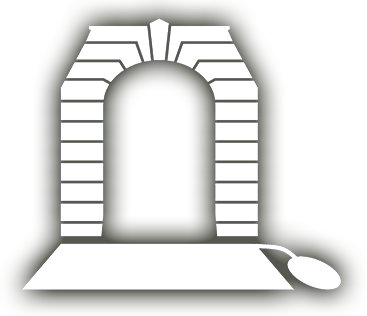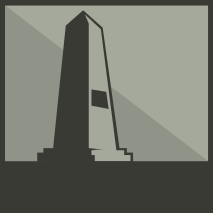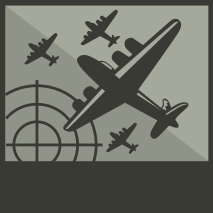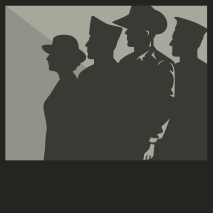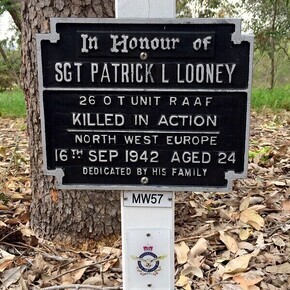
LOONEY, Patrick Lawrence
| Service Number: | 406694 |
|---|---|
| Enlisted: | 3 March 1941, Enlisted at Perth, WA |
| Last Rank: | Sergeant |
| Last Unit: | Operational Training Units (RAF) |
| Born: | Bunbury, Western Australia, Australia, 3 August 1918 |
| Home Town: | Mount Lawley, Vincent, Western Australia |
| Schooling: | St Patrick's Christian Brothers College, Perth, Western Australia |
| Occupation: | Railway Clerk (WAGR) |
| Died: | Flying Battle, North West Europe, 16 September 1942, aged 24 years |
| Cemetery: |
No known grave - "Known Unto God" Runnymede (Air Forces) Memorial, Surrey, England Panel 112 |
| Memorials: | Australian War Memorial Roll of Honour, International Bomber Command Centre Memorial, Runnymede Memorial |
World War 2 Service
| 3 Mar 1941: | Transferred Royal Australian Air Force, Aircraftman 2 (WW2), No. 5 Initial Training School Pearce | |
|---|---|---|
| 3 Mar 1941: | Enlisted Royal Australian Air Force, Sergeant, 406694, Enlisted at Perth, WA | |
| 24 Apr 1941: | Promoted Royal Australian Air Force, Leading Aircraftman | |
| 1 May 1941: | Transferred Royal Australian Air Force, Leading Aircraftman, No. 9 Elementary Flying Training School Cunderdin, Trained in a DH-82A Tiger Moth | |
| 30 Jun 1941: | Transferred Royal Australian Air Force, Leading Aircraftman, No. 4 Service Flying Training School Geraldton, RAAF Avro Anson Flight Training | |
| 17 Oct 1941: | Promoted Royal Australian Air Force, Sergeant, No. 4 Service Flying Training School Geraldton, Awarded Pilot Wings Badge | |
| 17 Nov 1941: | Embarked Royal Australian Air Force, Sergeant, 406694, 2 Embarkation Depot, Embarked from Newcastle for U.K. | |
| 30 Mar 1942: | Transferred Royal Australian Air Force, Sergeant, Royal Air Force - unspecified units, No. 15 S.F.T.S to train in a Miles Master Mk 1. | |
| 9 May 1942: | Transferred Royal Australian Air Force, Sergeant, Royal Air Force - unspecified units, No. 15 Advanced (Pilot) Flying Training Unit to train in Airspeed Oxfords. This unit acclimatised newly arrived pilots from the British Dominions to U.K. conditions. | |
| 26 Jun 1942: | Transferred Royal Australian Air Force, Sergeant, Operational Training Units (RAF), No. 26 O.T.U. for his Vickers Wellington Bomber Operational Training. | |
| 16 Sep 1942: | Involvement Royal Australian Air Force, Sergeant, 406694, Operational Training Units (RAF), Air War NW Europe 1939-45 |
Help us honour Patrick Lawrence Looney's service by contributing information, stories, and images so that they can be preserved for future generations.
Add my storyBiography contributed by Paul Lemar
LOONEY Patrick Lawrence
Patrick (Pat) was the son of William Paul LOONEY & Eliza Victoria Agnes HEHIR and was born on the 3rd of August 1918 in Symmons Street, Bunbury, WA.
He was the 3rd child born into the family of 4 children.
His parents were married on the 11th of December 1912 in Kalgoorlie, WA.
His mother was the daughter of William HEHIR & Esther BURNS and was born in 1886 in Huntley, Bendigo, VIC.
His father was the son of William Joseph HIGGINS & Margaret MCKENNA and was born on the 17th of August 1878 in Canning, WA.
His father was a telegraphist.
At the age of 23, Patrick enlisted into the RAAF on the 3rd of March 1941 at Mount Lawley and was allotted the service number 406694.
Four Pilot training courses were being conducted (Courses 10 – 13 of the Empire Air Training Scheme) at Pearce Initial Training School and Patrick was allocated to 12 Course “New Wings”, progressing to 4 Service Training, RAAF Geraldton.
At the completion of pilot training at Geraldton SFTS in 1941 each course had a percentage posted directly overseas and others for duties in Australia. Following two weeks' leave, the overseas postings, Patrick included, were assembled at 5 Embarkation Depot in Perth to await sailing directives.
In October 1941, postings were received for them to be sent to Sydney to join a ship bound for a destination overseas. The first leg of the journey began at the Perth Railway Station with sad farewells to wives, girlfriends and relatives and thoughts that it may be years before seeing each other again. The steam engine gave a whistle and a crowded train headed towards the East.
They spent ten days in No 2 Embarkation Depot, Lindfield, NSW before receiving news, that an overseas ship had accommodation for the group. No one knew where they were bound for - maybe the Middle East, USA or UK!
The only clue was that they were to proceed to Newcastle (NSW) and board a ship called the 'SS Themistocles'. On the 18th of November 1941, the ship sailed with an overseas contingent which included Patrick and 24 members 10-13 Courses.
The SS Themistocles sailed as a civilian passenger ship with all lights on and civilian passengers in addition to the below deck cabins with sergeants wearing very white wings. At sea on the first night they still had no idea where they were going. However, surprise of surprises, the ship was heading for the UK via Albany and Fremantle. What a turn up for those who had made fond farewells only two or three weeks earlier - these brave airmen off to war but now back again.
Wednesday the 26th of November 1941 was a great day for Albany. The RAAF contingent paraded through the town and School children were given the morning off to see them and on the 29th of November they were all in Fremantle again. At this stage all the contingent had survived the first month of overseas service. “Little did they know that of this group of 24, fifteen would be killed within the next 12 months”.
On the 5th of December, after anchoring a day in Gage Roads Fremantle to have a 4 inch gun mounted on the fore dock that they headed due west for South Africa.
They arrived at Durban on the 22nd of December 1941.
It was nearly Christmas and they made the most of a few days leave in Durban. Australians had a reputation - some good, some bad - mainly from the Army divisions going through to the Middle East.
Patrick joined a slow 5 knot convoy which called at Sierra Leone on the 16th of January 1942. After being chased by submarines and turning out to their gun posts to shoot down German bombers (which turned out to be RAF Arvo Anson’s) they reached Liverpool on the 18th of February 1942, exactly 3 months after leaving Sydney.
Ninety days confined on one ship, exercising daily with deck sports, card games in the evenings, sleeping and eating.
When they arrived in the UK, they were bundled on a train in Liverpool, lunch in London, pass fields of snow and delivered to Bournemouth 3 Personal Reception Centre on the south coast all in the one day.
It was April 1942 before most of them were sent to Advanced Flying Units in England with the RAF, to become accustomed to European flying conditions and eventual postings to operational squadrons.
Patrick and his No. 12 Course contingent were posted to No. 15 Advanced (Pilot) Flying Training Unit in Oxford where they trained in Airspeed Oxfords.
One of the pilots; Sergeant Bernard Rinian Roy Rutherford (406540) from 11 Course, was posted there also. Sergeant Rutherford was killed while flying solo in an accident at Burton Fleming, East Yorkshire on the 19th of May 42 in Airspeed Oxford aircraft L9647.
He was flying in tail numbering formation with Oxford R6358 when a collision occurred. The wing of the other aircraft struck the tail of his aircraft, which caused this aircraft to dive into ground at 10.30hrs near Pear Tree Farm, Burton Fleming. The other aircraft managed to land safely.
They buried Rinian in the Leconfield (St Catherine) Churchyard, he was 23 years old.
On completion of his training, Patrick was attached to 142 Squadron at RAF Grimsby, Lincolnshire.
Patrick’s first trip was Dusseldorf, Germany on the 10th of September. At 2100 hours they took off from the RAF Station Wing, Buckinghamshire, Satellite airfield armed with 4 x 500 lb General Purpose bombs. They were caught in searchlights and a lot of flak and came down to 3000 feet over the target.
Three crews turned back, two because they couldn't get height and Bob Carson because his starboard throttle became disconnected.
Downs (Alexander Irvine Lewis Downs 403565) was piloting Wellington DV867, nothing was head from the aircraft after take-off and it failed to return to base. The aircraft had been shot down at 0032 hours by a German night fighter and crashed between Stramproy and Hunsell (Limburg). All the crew members were killed.
Alexander was buried in the Jonkerbos War Cemetery, Gelderland, Netherlands.He was 25 years old.
Their second trip was to Bremen. Several had to turn back including Pat because one of his engines caught fire.
Pat was transferred to 26 Operational Training Unit in Cheddington.
Pat was reported missing on the 16th of September, presumed shot down in a flying battle. He was flying a Vicker Wellington DV723. He had taken off from the RAF Station Wing, Buckinghamshire, Satellite airfield at 2019 hours on the 16th of September 1942 to attack Essen, Germany. Nothing was heard from the aircraft after take off and it did not return to base
Following post war enquiries and investigations, it was recorded in 1949 that the missing crew had no known grave.
Patrick was the only Australian in the crew of 5, he was 24 years old.
Biography contributed by Carol Foster
Son of William and Victoria Agnes Looney of Mt Lawley, WA
Plane was a Wellington and was lost while on air operations over Germany
Biography contributed by Maurice Kissane
Patrick Lawrence Looney was born Patrick Laurence Looney in Bunbury in Western Australia in 1918.
His 1918 WA Birth Registration Records confirm that Patrick's full legal name is Patrick Laurence Looney - not Patrick "Lawrence" Looney.
His family wanted Lawrence as his middle name but that name was recorded as Laurence. His 1918 WA Birth Registration Record No. 6600289, is attached.
That confirms Laurence not Lawrence is his registered middle name.
This would become an issue later on with duplicate records being created for the same service number.
Partrick was educated at St Patrick's CBC College in Perth. He gained his Junior certicate in 1934. Then got what he saw as a good secure office job in the WAGR.
He was a Railway Goods General Clerk.
Patrick commenced his required CMF militia service in 1940 as a signaller. However he later volunteered for the RAAF.
His CMF muster was signals because Telegraphy was part of his Railways Goods General Clerk job. He could tap out morse code at a rate of 15 words per minute as per his File.
The Telegraph lines followed railway lines to aid long distance railway communications plus facilitate Telegraph Line Maintennace.
However RAAF Recruiting Officers were quite interested in applicants with Telegraphy skills.
Patrick had wanted to be an RAAF clerk as he could type at a speed of 30 words per minute as per his file. However the RAAF Recruiting Officer put a line thru that preference. He then inserted W/T.
W/T RAAF Trade includes WOpAG. Hence Patrick was enlsted for Aircrew Training. For he had passed his requisite Aircrew Medical. The RAAF Recruiting Officer though that Patrick would likely be sorted as WOpAG.
However his RAAF Aircrew Medical status included Pilot.
Patrick printed and signed his full name on his RAAF Attestation. Patrick "Lawrence" Looney. However when his RAAF unit later sighted his birth certificate, a line was put thru "Lawrence". The RAAF inserted Laurence above that line.
Following his initial Aircrew sorting, the man who wanted to be a RAAF clerk was required to train as a RAAF Pilot. He mastered the Tiger Moth at RAAF Base Cunderdin. Patrick then mastered the Avro Anson to graduate with his RAAF Pilot's wings at RAAF Base Geraldton.
Patrick was then streamed for Bomber Command. For he could now fly the requisite twin engine Avro Anson.
Hence, his aspirations of helping the war effort by doing RAAF clerical work, preferably in W.A. were now over.
Patrick was sent to the U.K. for his Heavy Bomber Conversion. While still at No. 26 Operational Training Unit, Patrick was required to fly his first Ops. For AM "Bomber" Harris wanted Operational Training Unit crews to make up Aircraft numbers on his large scale "millennial" raids. He saw that as one was of getting his green OTU crews some operational experience.
Patrick was sent to Germany on 16 Sep 1942 where his mission was to bomb the Krupp works at Essen.
He failed to return. Hence his crew were posted MIA.
Post war research by the Dutch Air War (1939-1945) Study Group plus Night Fighter claims believe that his RAF Vickers Wellington, DV723 PB-H, was shot down over the North Sea.
He was homeward bound from his target.
Patrick was the sole RAAF Aircrew member in DV723. He was the Pilot. His 26 OTU RAF Wellington Bomber was crewed by RAF Airmen with an RAAF Pilot as their Aircraft captain.
There were no survivors. Patrick's RAF Wellington Bomber DV723 Aircrew were MIA presumed dead.
His widowed mother was notified that Patrick was posted MIA but like all mothers, she lived in hope.
Victoria Agnes Looney of Mt Lawley was notified via a Telegram on 25 May 1943 that her son was now presumed dead for "Official Purposes". His death was presumed to have occurred on 16 September 1942.
Patrick is memorialised on the Runnymede Air Forces Memorial for those without a known grave.
Commonweath War Graves record his name as Patrick Lawrence Looney, likewise the Australian War Memorial Honour Roll.
His family published his full name in an attached 1946 In Memorium Notice with Lawrence as his middle name.
However DVA Nominal Roll and NAA RAAF Service File record his middle name as "Laurence" not Lawrence.
For his WA birth certificate records his official middle name as Laurence. The RAAF unit had sited that and put a line thru Lawrence, then inserted his registered middle name which is Laurence.
Hence there are currently two records for his 406694 service number. The difference between these two records is the spelling of his official middle name.
His middle name was registered in 1918 as Laurence not Lawrence.
RAAF and DVA used official "Laurence" middle name but not AWM and CWGC records. The latter used his preferred family name which is Patrick "Lawrence" Looney. That was how Patrick spelt his name before RAAF cited his birth certificate.
It should be noted that his 1943 Death presumption Telegram sent to his mother used his families prefered middle name spelling, "Lawrence". Likewise his CWGC Record. Mispelt official names are not uncommon in service records.
Patrick had volunteered to serve as a RAAF Clerk but ended up as an RAF Bomber Command Pilot. It was his ability to telegraph morse code, rather than his ability to type that sealed his fate. The needs of the service must come first. Lest We Forget.
Research links and documents cited are provided.

